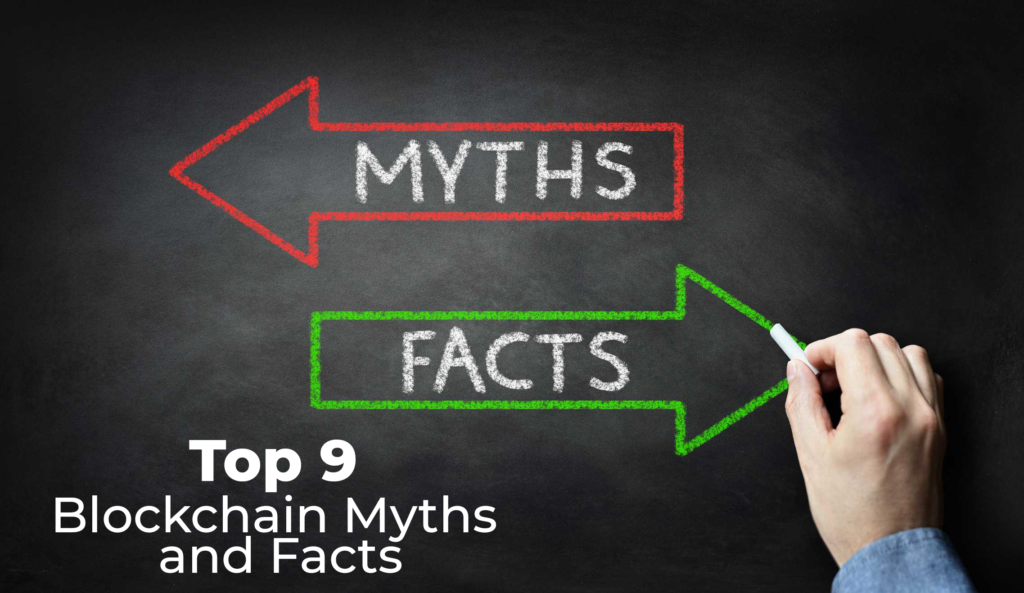
The impact of technological advancements in the existing world on the day to day life of every individual has a huge role in driving its adoption. On the other hand, users have to understand the influence of new technologies like Blockchain for gaining the most out of them. However, more often than not, new technologies are often associated with considerable levels of confusion.
The confusion generally results in variable perceptions of new technology, thereby causing the development of myths. Among the various technological advancements in recent times, Blockchain has been a prominent contender. So, the lack of clarity in understanding Blockchain has resulted in the creation of many Blockchain myths over the years.
It is possible to achieve a clear understanding of Blockchain technology only when you can ward off all the doubts regarding it. The following discussion helps you unravel some of the commonly assumed misconceptions about Blockchain technology. You can find an outline of Blockchain myths and facts that can completely straighten out your understanding of Blockchain technology.
Most Common Blockchain Myths and Facts Behind Them
Is it important to reflect on Blockchain myths for a better understanding of the technology? Some would wonder where exactly the source of all the myths is! Any Blockchain enthusiast knows about the drastic fluctuations in the Blockchain landscape over the years. The sudden rise of Bitcoin, followed by its crash, provided the ideal foundation for different perceptions of its functionalities.
Most important of all, the wide array of benefits with Blockchain technology has also been a crucial factor in driving misinformation and confusion. Now, let us take a look at some of the top myths and facts about Blockchain that can help you find the difference between what Blockchain is and what it is not.
Myth 1: Every Blockchain is Public
Fact: Many people have assumed this fact on the basis of the introduction of public global blockchains like Bitcoin. However, this is one of the notable Blockchain myths that can confuse any beginner. As a matter of fact, public blockchains are not the only type of Blockchain. Private and hybrid blockchains are also suitable for different use cases.
The introduction of Bitcoin resulted in a particular phenomenon across all financial institutions and private enterprises. The particular phenomenon is known as permissioned Blockchain, also known as federated or private Blockchain. Many distributed ledger technologies you find in the present world are examples of different types of blockchain. So, that’s one myth down for you.
Myth 2: Blockchain is same as Crytocurrencies
Fact: The first-ever instance of mainstream recognition for Blockchain was the introduction of Bitcoin in 2009. So, many people confuse Blockchain as a cryptocurrency. However, cryptocurrencies are basically another application of Blockchain technology. Blockchain is basically a system that stores records of transactions and the records are maintained throughout different computers linked to each other via a peer-to-peer network.
The blockchain serves as an open and distributed ledger that can help in recording transactions between different parties. However, common Blockchain myths paint blockchain as a cryptocurrency. So, it is essential to understand that cryptocurrencies are digital currency that could bypass the government regulatory controls over the currency.
In addition, cryptocurrencies do not require the involvement of intermediaries. So, blockchain technology serves as the ideal foundation for building cryptocurrencies. That does not mean that all cryptocurrencies use blockchain technology. The example of IOTA cryptocurrency shows the use of cryptocurrencies without blockchain technology.
IOTA uses a Directed Acyclic Graph (DAG), a form of distributed ledger technology. On the other hand, blockchain is not specifically intended for cryptocurrencies. The applications of blockchain in healthcare for streamlining medical data and better administration prove the same.
Myth 3: Blockchains are Invulnerable
Fact: The primary basis of Blockchain technology is encryption of information related to specific transactions between two parties. The majority of blockchains like the Bitcoin blockchain use the SHA-256 cryptographic hash algorithm. Most important of all, many experts commend SHA-256 for its potential to address encryption requirements for the foreseeable future.
However, if the algorithm is compromised, then there will be a lot more problems than the entirety of blockchain itself. Furthermore, there are variable perspectives on the vulnerability of blockchain that contradict the absolute security claim of Blockchain technology. Some experts perceive that smaller blockchains could be easily compromised at a faster rate. On the other hand, larger and public blockchains present better scope for security from cyber attacks.
Myth 4: Blockchain Technology Will Bring Groundbreaking Changes in the World
Fact: Blockchain technology presents many promising benefits, and therefore people are liable to believe in this myth about Blockchain. Furthermore, news reports of oil-backed cryptocurrency, Petro, in Venezuela, and the Bank of England’s growing interest in cryptocurrencies are also fueling such myths.
A closer reflection on the cases shows that the hype around blockchain technology is exaggerated. Blockchains can definitely reduce the chance of fraud. However, they cannot completely ensure the removal of threats of online fraud. In some cases, blockchain technology could actually turn out to be an inefficient digital transformation of a conventional ledger.
Therefore, the potential of blockchain technology is being painted more than it should be. A practical impression of blockchain’s capabilities is the immediate need of the hour. So, it is essential to note that while blockchain has the potential to change the world, it is still far away from achieving that objective.
Myth 5: Blockchain is a Cloud-based Database
Fact: One of the common Blockchain myths implies that they are just cloud-based databases. In reality, you should download the blockchain and run it on internet-enabled computers for operating it. Any computer in the world running a blockchain is accounted for as a node on the network. The strength of the internet connection of the computer running blockchain is a major factor in strengthening the blockchain network.
Another difference between blockchain and cloud-based databases is that you don’t have to store digital files in formats such as Word documents. On the contrary, blockchains store records with a Proof of Existence. The Proof of Existence clearly showcases the evidence that a specific document exists without showing the actual document.
Myth 6: All Transactions on Blockchains are Anonymous
Fact: The most critical aspect of blockchain myth vs. reality comparison is the anonymity factor. Almost every newcomer to the blockchain landscape assumes that blockchain-based cryptocurrencies can help in making anonymous payments. Well, the statement is not completely false.
The blockchain records only the public addresses of the wallets while avoiding disclosure about the name of the wallet owner. However, recent reports have shown that the use of cryptocurrencies for making payments for illegal activities could be traceable. If anyone can link the public address of the wallet with the real-life identity of an individual, then the former can trace the entire list of past transactions.
Myth 7: Blockchain is Free
Fact: This is obviously one of the most common Blockchain myths you must have come across. Although the cost of blockchain with respect to Bitcoin has been primarily associated with the use of powerful computers for solving mathematical equations, the true cost paints a completely different picture.
Bitcoin mining requires expensive, powerful hardware with higher electricity consumption. Mining cryptocurrency can consume around 140 terawatt-hours of electricity, thereby indicating a substantial cost. So, there is no reason to believe that Blockchain is free, or it will be anytime soon in the future.
Myth 8: Tokens are the same as Coins
Fact: The applications of Blockchain in the financial sector have been responsible for a wide range of blockchain myths. Many people use the terms token and coins interchangeably without knowing the exact difference between them. The crypto coin is local for a specific blockchain such as Ether or Bitcoin. All these coins exist without anything else in the blockchain and serve just like a currency.
On the other hand, tokens refer to assets issued by a blockchain-based project. You can utilize the tokens as payment methods within the system while delivering similar functionalities as coins. However, the primary difference between tokens and coins is that coins provide the privilege of participating in a network while tokens can serve as important elements of a digital resource or provide representation for a share in the company.
Myth 9: Smart Contracts are Valid Legal Contracts
Fact: This is also one of the prominent Blockchain myths that compare smart contracts with valid legal contracts. Smart contracts are basically lines of code that can execute different activities naturally while addressing specific conditions. So, they are not qualifying as legal contracts. You can present smart contracts as proof of whether certain conditions have been fulfilled or not. However, smart contracts can serve as incredible assets in driving digital transformation despite the confusing legal position.
Are These Blockchain Myths and Facts Really Important?
The above-mentioned Blockchain myths and facts are very obstructive. Moreover, they can lead to bad business decisions. Without validating the Blockchain facts against these myths, a business can waste precious resources, which may have otherwise been used to increase the flexibility of businesses.

In the Philippines, one of the leading provider of MLM System is Geer IT Solutions, Inc. They are providing app, software and websites to their customers.
Products:


